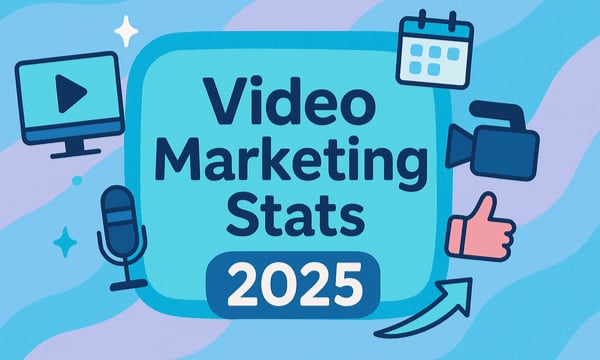You might not realize it but color greatly influences how we feel and think about everything from brands and logos, to movies and animations. If we mentioned the Frozen films, you'd probably imagine bright pink and purple scenes (and spontaneously start singing 'Let it Go' 😂). Whereas the Corpse Bride conjures images of dark grey and blue. These color palettes help set the right tone for each story to play out.
The same idea applies to your videos. Choosing the right colors for your creations can help your video stand out, reinforce your message and most importantly, make it more memorable! So, how do you build the perfect palette? It all starts with an understanding of color theory and the different emotions each color sparks, which is exactly what we're covering in this blog.
What is color theory?
First things first, you're probably wondering what color theory is. Sounds super scientific right? 🤓*Spoiler alert* it's not! Simply put, color theory is the tradition of mixing and combining colors to help define them and explain how they relate to each other.
Leonardo Da Vinci and Isaac Newton pioneered color theory with Newton designing the first color wheel in 1666. The color wheel consists of three primary colors (red, yellow and blue), three secondary colors (which are created when the primary colors are mixed: green, orange and purple) and six tertiary colors (made from primary and secondary colors like red-orange or blue-green).
There are a few rules that apply to the color wheel that can help you choose colors that go well together, contrast each other or build a more harmonious palette. These are:
Complementary colors
These are two colors that are opposite each other on the color wheel like blue and orange or red and green. The two colors can work well together because they're contrasting and so imagery or text really pops. However, too much contrast can be a little jarring so use these sparingly for maximum impact.
Analogous colors
These colors sit next to each other on the wheel like yellow, orange and red. They're often used for company color schemes because naturally one color will dominate, one will support and one will accent. This not only makes for an aesthetically pleasing effect but it can help draw the eye to certain points on the screen.
Triadic colors
Triadic colors are those evenly spaced around the wheel in the shape of a triangle like orange, purple and green. These colors work together because they're simultaneously contrasting and harmonious like the logos of Fanta, Taco Bell and Burger King.
.gif)
Why is color so important in animation?
Now you know the basics of color theory, it's time to get into the world of color psychology. This is the really interesting part - how can you make people feel different emotions by using certain colors.
Warm colors
These include red, yellow, orange and are commonly associated with energy, passion and positivity. Think sunrises, sunsets, fire and fall leaves. When broken down their meanings go further:
Red = passion, love, and importance BUT can also represent anger, danger and violence. Plus, internationally red has different meanings again, for instance in China, red is associated with luck, happiness and prosperity.
Orange = change, creativity and energy since it's linked to the changing color of leaves in the fall.
Yellow = happiness, sunshine and hope. Although like red, it also has different international meanings to be aware of. In Japan yellow represents courage, in India it's for merchants and in Egypt it's a color of mourning.
.gif)
Cool colors
These include green, blue and purple and are often linked to the night, water and nature which gives them a calming effect. But let's look at them in more detail:
Green = new beginnings, growth and health. However, like lots of colors it also has a darker side associated with jealousy and naivety.
Blue = trust, peace and strength which is why darker blues are often the color of choice for corporations offering services like accounting, legal advice or professional services.
Purple = wealth, luxury and imagination since traditionally creating purple dyes was much more expensive, only royals wore clothes of that color.
.gif?width=810&name=ezgif.com-video-to-gif%20(84).gif)
As you can see, we subliminally take lots of different meanings from each color, which is why the colors you choose for your video are so important. That's not to say you have to really read into the symbolism of each scene but having an awareness of these can really help to reinforce your message.
How to choose the right color palette for your video
So, how do you take this information and apply it to your own videos? There are three key elements you need to think about when choosing the color palette for your video. We recommend working through these as part of your storyboarding process, so you can see how the colors will play out through your video.
Consider the story you're telling
First things first, think about the story you're trying to tell. As we know, most stories follow one of seven main plot lines and different colors can help you take your audience on that journey. For instance, if it's a 'rags to riches' tale, the colors you start your video with will probably be dark and muted and they'll gradually transform into radiant purples, greens and yellows.
This principle can work really well for educational videos too. You might start off with a very paired back color scheme and gradually add more colors in as the video develops to reinforce the fact that their knowledge on the topic is expanding and getting richer.
Remember, just because you have a color scheme, doesn't mean it can't change and evolve as your story progresses!
Consider what you want the audience to feel
Next, think about what you want your audience to finish your video feeling. Are you wanting to inspire them to take action, to recognize the gravity of a situation or persuade them to buy?
As we saw earlier, red can help reinforce the importance of an idea and blue can depict sadness as well as loyalty which makes them a great choice of color to share crucial messages like health and safety information or news about a charity in need.
Whereas oranges and yellows will leave your audience energized and full of positivity to take on the challenge you've set.
Consider your brand
While your video can have a completely different color scheme to your brand colors, it's a good idea to think about where the video will be used. Will it be on your website or on other branded assets? If so, your video still has to sit well with the rest of the colors on that page so make sure they're either aligned to your brand colors or complement them.
Similarly, if your video is for sales or marketing, including your brand colors can help your logo and company to stick in your audience's head. The last thing you want is to present too many different colors and designs so that your core message gets lost. So keep brand colors in mind, but don't feel bound to repeat them!
To start experimenting with color in your videos, start a free 7-day trial of VideoScribe today 👇



.png)


![How to create animation magic [3-part guide to video success]](https://blog.videoscribe.co/hubfs/How%20to%20create%20animation%20magic%20guide%20VideoScribe.png)


%20(1).png)


COMMENTS